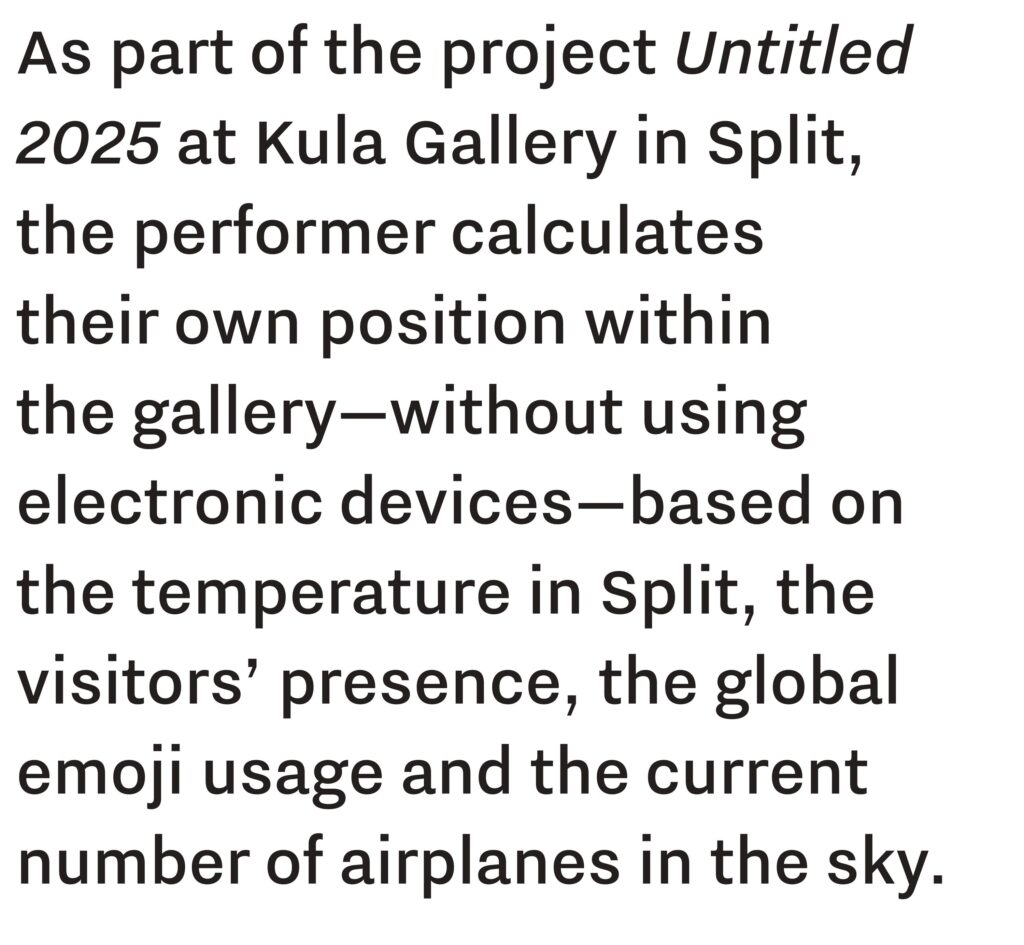

»On the subsequently constructed but stationary wall of Kula Gallery, a seemingly simple sentence offers visitors an explanation of the performance: “As part of the ‘Untitled 2025’ project at Kula Gallery in Split, the performer calculates his position within the gallery – without using electronic devices – based on the temperature in Split, the presence of visitors, global emoji usage, and the current number of planes in the sky.” While the text appears transparent, it actually opens up a space of radical uncertainty. While the performance’s parameters may appear specific at first, they seem unrelated and almost random – their relationship to the outcome (the performer’s position in the space) remains completely obscure. Even if executed with the aid of sophisticated technology, their rationale would still be enigmatic. This gives rise to a key question: how do we interpret the performance when it has no basis in recognised epistemological structures?
Central to the work is the performer’s body positioned behind a movable table, a body that shifts, yet without mechanical predictability, guided by an internal performance logic hidden from the observer. In this context, ‘Untitled 2025’ expresses the tension between the declarative (parameters as a model of reality) and the actual (a tangible but elusive performance). Simultaneously, the gallery space is both constructed and stripped of subjectivity: it is no longer perceived through the stable coordinates of the observer’s gaze, but as a dynamic interplay of uncertain variables that suggest an algorithm rather than a coherent system of meaning.
Tomo Savić Gecan’s work invites us to consider the relationship between perception, measurement, and presence: between what can be precisely located and what unfolds beyond the scope of understanding. The visitor is activated not through traditional participation, but as a variable element within a system that generates the very conditions of the performance. In a subtle yet deeply destabilising manner, ‘Untitled 2025’ explores the way in which contemporary logic of data collection – even when merely referenced – redefines our understanding of the body, space, and the reality of the artistic act.«
Dalibor Prančević
Tomo Savić-Gecan was born in Zagreb in 1967. He graduated from the Fine Arts Academy in Milan in 1993. His work was featured in numerous solo exhibitions in Croatia and abroad, such as the exhibitions at the Student Centre Gallery in Zagreb (1994), Kapelica Gallery in Ljubljana (1994), M6 gallery in Riga (1995), Spaces Gallery in Cleveland (1996), Extended Media Gallery (with Julije Knifer) in Zagreb (2005), Bergen Kunsthall in Bergen (2010), Museum Jeu de Paume in Paris (2010), the Zuidplein public area in Amsterdam, Van Abbe Museum of Contemporary Art in Eindhoven (2016) and Museum of Modern and Contemporary Art (Mali salon Gallery) in Rijeka (2017). His work was included in group exhibitions such as in the Museum of Contemporary Art in Belgrade (2001), Królikarnia National Museum in Warsaw (2001), Technical Museum in Zagreb (2002), Museum of Contemporary Art Zagreb (2002 and 2012), Kunsthalle Fridericianum in Kassel (2003), Apexart Gallery in New York (2000 and 2007), PS1 Museum in New York (2004), De Appel art centre in Amsterdam (2009), Kunsthall Bergen in Bergen (2010), Witte de With Center for contemporary art in Rotterdam (2011), (ON)begane Grond in Antwerpen (2015), etc. He has participated in big international events like Manifesta 3 in Ljubljana (2000), the 51st Venice Biennale (2005) and the Taipei Biennial (2012). In 2020, a retrospective exhibition was dedicated to him at the Museum of Contemporary Art in Zagreb, and in 2022, he represented Croatia at the 59th Venice Biennale.